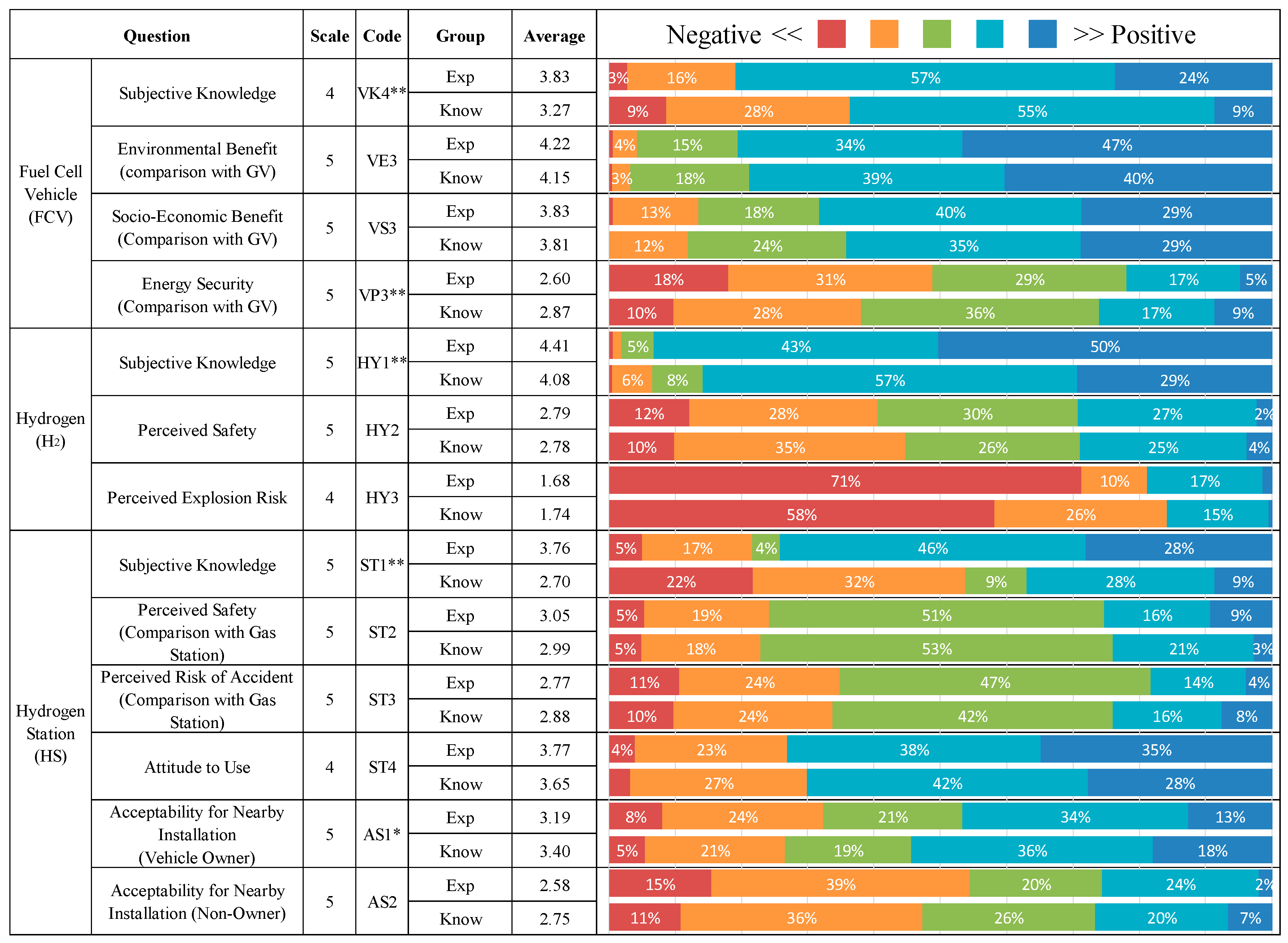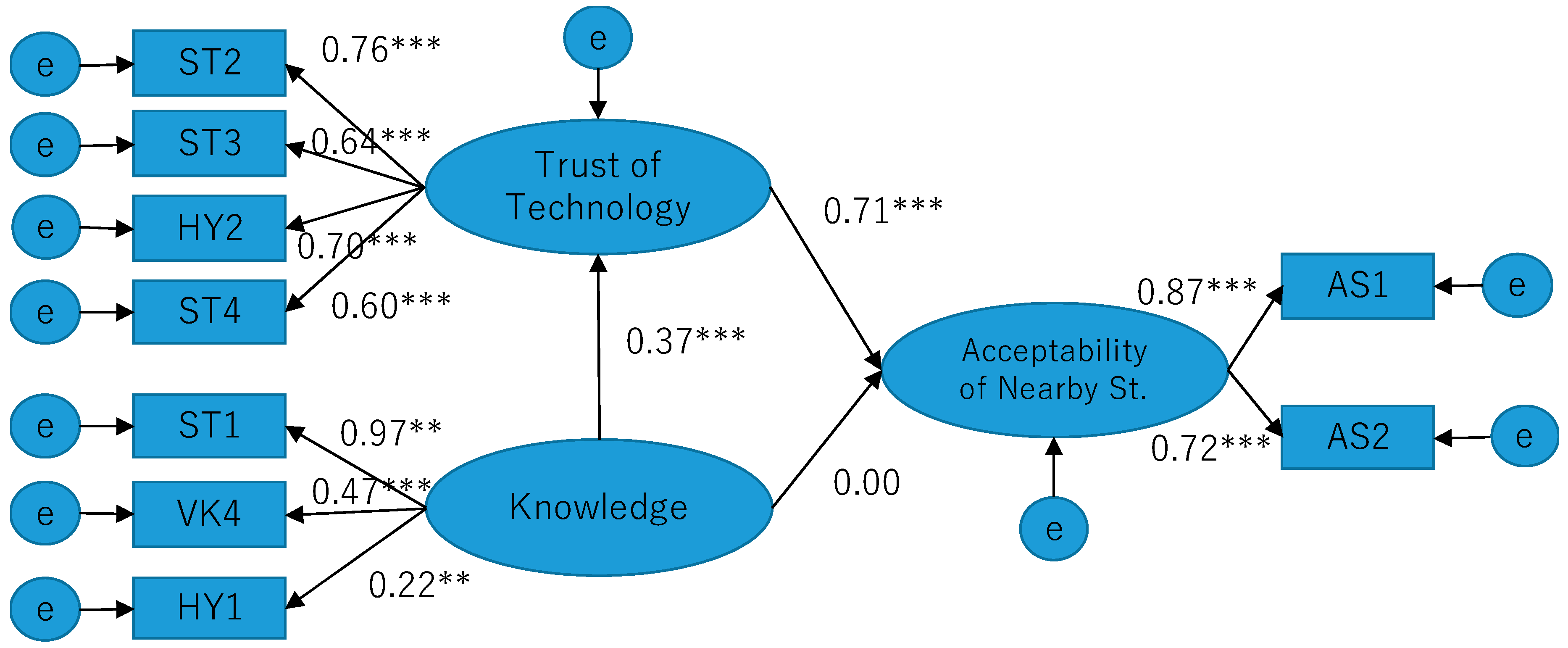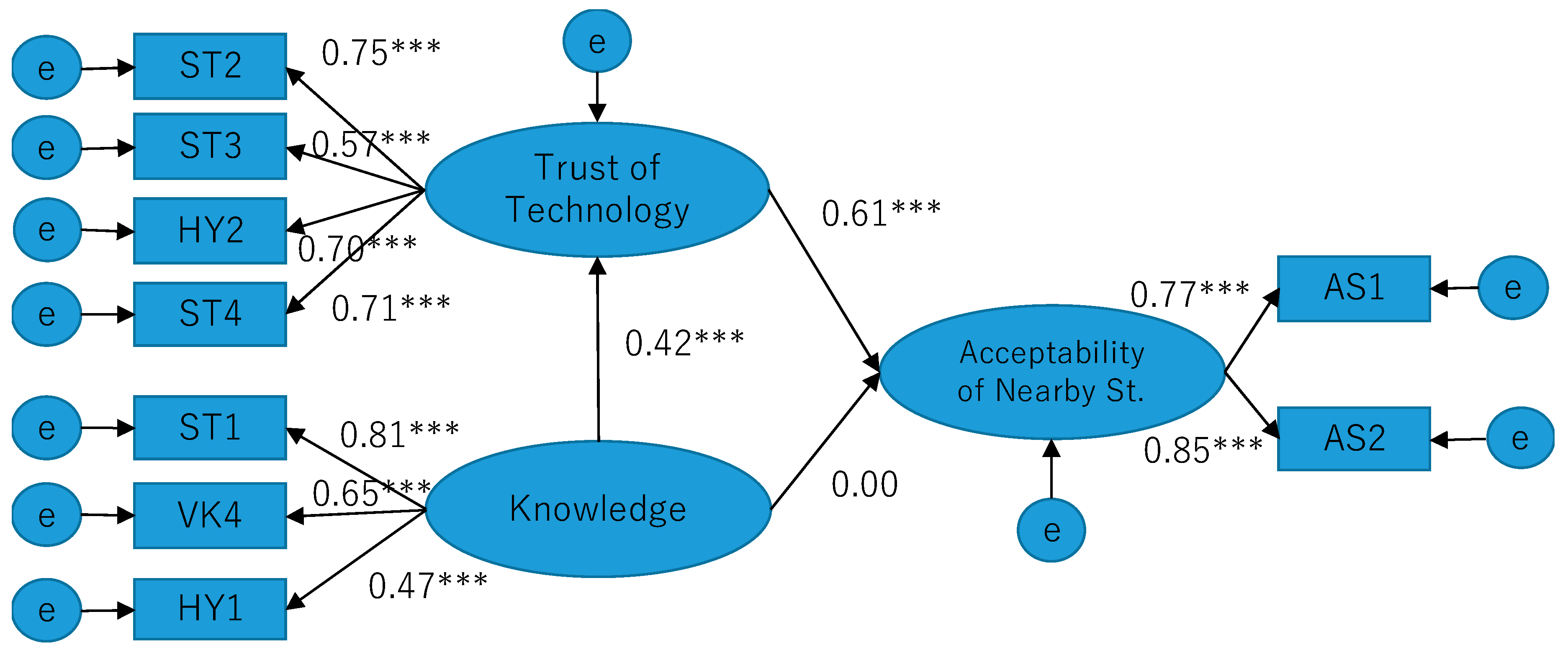How Knowledge about or Experience with Hydrogen Fueling Stations Improves Their Public Acceptance
Abstract
1. Introduction
2. Materials and Methods
2.1. Survey Questions
2.2. Sample
2.2.1. Environmental Energy Event for the General Public
2.2.2. Hydrogen Energy Seminar
3. Results and Discussion
3.1. Average Score and Response Ratio
3.2. Factor Analysis
3.3. H2 Station Acceptability Model
3.4. Contribution to Hydrogen Energy Policy
4. Conclusions
Author Contributions
Funding
Acknowledgments
Conflicts of Interest
References
- NEDO (New Energy and Industrial Technology Development Organization). Hydrogen Energy White Paper; NEDO: Omiya-cho, Japan, 2015; pp. 89–100. [Google Scholar]
- Strategic Roadmap for Hydrogen and Fuel Cells, Japan Ministry of Economy, Trade and Industry. Available online: https://www.meti.go.jp/press/2018/03/20190312001/20190312001-1.pdf (accessed on 10 July 2019).
- Outline of the Strategic Roadmap for Hydrogen and Fuel Cells. Japan Ministry of Economy, Trade and Industry. Available online: https://www.meti.go.jp/english/press/2019/pdf/0312_002a.pdf (accessed on 10 July 2019).
- Daiwasoken Consulting Report. Daiwa institute of Research, February 2019. Available online: https://www.dir.co.jp/report/consulting/other/20190222_020637.pdf (accessed on 10 July 2019).
- Sakamoto, J.; Nakayama, J.; Nakarai, T.; Kasai, N.; Shibutani, T.; Miyake, A. Effect of gasoline pool fire on liquid hydrogen storage tank in hybrid hydrogen–gasoline fueling station. Int. J. Hydrogen Energy 2016, 41, 2096–2104. [Google Scholar] [CrossRef]
- Nakayama, J.; Kasai, N.; Shibutani, T.; Miyake, A. Security risk analysis of a hydrogen fueling station with an on-site hydrogen production system involving methylcyclohexane. Int. J. Hydrogen Energy 2019, 44, 9110–9119. [Google Scholar] [CrossRef]
- Tsunemi, K.; Kihara, T.; Kato, E.; Kawamoto, A.; Saburi, T. Quantitative risk assessment of the interior of a hydrogen refueling station considering safety barrier systems. Int. J. Hydrogen Energy 2019, 44, 23522–23531. [Google Scholar] [CrossRef]
- Jennings, P. New directions in renewable energy education. Renew. Energy 2009, 34, 435–439. [Google Scholar] [CrossRef]
- Duan, H. The public perspective of carbon capture and storage for CO2 emission reductions in China. Energy Policy 2010, 38, 5281–5289. [Google Scholar] [CrossRef]
- Bühler, F.; Cocron, P.; Neumann, I.; Franke, T.; Krems, J.F. Is EV experience related to EV acceptance? Results from a German field study. Transp. Res. Part F Traffic Psychol. Behav. 2014, 25, 34–49. [Google Scholar] [CrossRef]
- Jabeen, F.; Olaru, D.; Smith, B.; Braunl, T.; Speidel, S. Acceptability of Electric Vehicles: Findings from a Driver Survey. In Shaping the Future: Linking Research, Policy and Outcomes; Australasian Transport Research Forum: Perth, Australia, 2012. [Google Scholar]
- Burgess, M.; King, N.; Harris, M.; Lewis, E. Electric vehicle drivers’ reported interactions with the public: Driving stereotype change? Transp. Res. Part F Traffic Psychol. Behav. 2013, 17, 33–44. [Google Scholar] [CrossRef]
- Bögel, P.; Oltra, C.; Sala, R.; Lores, M.; Upham, P.; Dütschke, E. The role of attitudes in technology acceptance management: Reflections on the case of hydrogen fuel cells in Europe. J. Clean. Prod. 2018, 188, 125–135. [Google Scholar] [CrossRef]
- Achterberg, P.; Houtman, D.; van Bohemen, S.; Manevska, K. Unknowing but supportive? Predispositions, knowledge, and support for hydrogen technology in the Netherlands. Int. J. Hydrogen Energy 2010, 35, 6075–6083. [Google Scholar] [CrossRef]
- Hickson, A.; Phillips, A.; Morales, G. Public perception related to a hydrogen hybrid internal combustion engine transit bus demonstration and hydrogen fuel. Energy Policy 2007, 35, 2249–2255. [Google Scholar] [CrossRef]
- Mourato, S.; Saynor, B.; Hart, D. Greening London’s black cabs: A study of driver’s preferences for fuel cell taxis. Energy Policy 2004, 32, 685–695. [Google Scholar] [CrossRef]
- Schwartz, S.H. Normative Influences on Altruism. In Advances in Experimental Social Psychology; Berkowitz, L., Ed.; Academic Press: New York, NY, USA, 1977; Volume 10, pp. 221–279. [Google Scholar]
- Ajzen, I. The theory of planned behavior. Organ. Behav. Hum. Decis. Process. 1991, 50, 179–211. [Google Scholar] [CrossRef]
- Huijts, N.M.A.; Molin, E.J.E.; van Wee, B. Hydrogen fuel station acceptance: A structural equation model based on the technology acceptance framework. J. Environ. Psychol. 2014, 38, 153–166. [Google Scholar] [CrossRef]
- Huijts, N.M.A.; van Wee, B. The evaluation of hydrogen fuel stations by citizens: The interrelated effects of sociodemographic, spatial and psychological variables. Int. J. Hydrogen Energy 2015, 40, 10367–10381. [Google Scholar] [CrossRef]
- Itaoka, K.; Saito, A.; Sasaki, K. Public perception on hydrogen infrastructure in Japan. Int. J. Hydrogen Energy 2017, 42, 7290–7296. [Google Scholar] [CrossRef]
- Mizuho Information and Research Institute. Suiso shakaijuyousei ni kansuru chousa [Hydrogen’s Social Acceptance Research]; Mizuho Information and Research Institute: Tokyo, Japan, 2008. (In Japanese) [Google Scholar]
- Mizuho Information and Research Institute. Nenryoudenchi, suiso ni kansuru shakaijuyouseichousa [PEFC, Hydrogen’s Social Acceptance Research]; Mizuho Information and Research Institute: Tokyo, Japan, 2009. (In Japanese) [Google Scholar]
- Ono, K.; Tsunemi, K. Identification of public acceptance factors with risk perception scales on hydrogen fueling stations in Japan. Int. J. Hydrogen Energy 2017, 42, 10697–10707. [Google Scholar] [CrossRef]
- Ono, K.; Kato, E.; Tsunemi, K. Does risk information change the acceptance of hydrogen refueling stations in the general Japanese population? Int. J. Hydrogen Energy 2019, 44, 16038–16047. [Google Scholar] [CrossRef]
- Martin, E.; Shaheen, S.A.; Lipman, T.E.; Lidicker, J.R. Behavioral response to hydrogen fuel cell vehicles and refueling: Results of California drive clinics. Int. J. Hydrogen Energy 2009, 34, 8670–8680. [Google Scholar] [CrossRef]
- Hardman, S.; Chandon, A.; Shiu, E.; Steinberger-Wilckens, R. Cunsumer attitudes to fuel cell vehicles post trial in the United Kingdom. Int. J. Hydrogen Energy 2016, 41, 6171–6179. [Google Scholar] [CrossRef]
- Assefa, G.; Frostell, B. Social sustainability and social acceptance in technology assessment: A case study of energy technologies. Technol. Soc. 2007, 29, 63–78. [Google Scholar] [CrossRef]
- Cabinet Office. Number of License Holders. Available online: https://www8.cao.go.jp/koutu/taisaku/h30kou_haku/zenbun/genkyo/h1/h1b1s2_3.html (accessed on 27 September 2019).
- Hienuki, S.; Noguchi, K.; Shibutani, T.; Saigo, T.; Miyake, A. The Balance of Individual and Infrastructure Values in Decisions Regarding Advanced Science and Technology. Sustainability 2019, 11, 3385. [Google Scholar] [CrossRef]




| Question | Scale | Code | |
|---|---|---|---|
| Fuel Cell Vehicle (FCV) | Subjective Knowledge | 4 | VK4 |
| Environmental Benefit (comparison with gasoline vehicle) | 5 | VE3 | |
| Socioeconomic Benefit (comparison with gasoline vehicle) | 5 | VS3 | |
| Energy Security (comparison with gasoline vehicle) | 5 | VP3 | |
| Hydrogen (H2) | Subjective Knowledge | 5 | HY1 |
| Perceived Safety | 5 | HY2 | |
| Perceived Explosion Risk | 4 | HY3 | |
| Hydrogen Station (HS) | Subjective Knowledge | 5 | ST1 |
| Perceived Safety (comparison with gas station) | 5 | ST2 | |
| Perceived Risk of Accident (comparison with gas station) | 5 | ST3 | |
| Attitude toward Use | 4 | ST4 | |
| Acceptability for Nearby Installation (Vehicle Owner) | 5 | AS1 | |
| Acceptability for Nearby Installation (Nonowner) | 5 | AS2 | |
| Age Distribution | Gender | ||
|---|---|---|---|
| <19 | 16 | Male | 423 |
| 20–29 | 36 | ||
| 30–39 | 80 | ||
| 40–49 | 103 | Female | 55 |
| 50–59 | 99 | ||
| 60–69 | 86 | ||
| 70–79 | 39 | Unknown | 62 |
| >80 | 9 | ||
| Unknown | 72 | ||
| Total | 540 | Total | 540 |
| Data | Title |
|---|---|
| 4/2016 | The 6th Yokohama Hydrogen Energy Council Seminar—Toward the Realization of a Clean Energy Society—Seminar held via industry–government–academia collaboration |
| 7/2016 | Cross-Ministerial Strategic Innovation Program (SIP) Energy Carrier Public Symposium 2016 |
| 10/2016 | Workshops attended by members of Japan Society for engineering |
| 10/2016 | The 7th Yokohama Hydrogen Energy Council Seminar—Toward the Realization of a Clean Energy Society—Seminar held via industry–government–academia collaboration |
| 12/2016 | Yokohama National University, Center for Creation of a Symbiosis Society with Risk, 5th Symposium “Considering the Effectiveness and Challenges of Risk Methods” |
| 4/2017 | The 8th Yokohama Hydrogen Energy Council Seminar—Toward the Realization of a Clean Energy Society—Seminar held via industry–government–academia collaboration |
| 7/2017 | Cross-Ministerial Strategic Innovation Program (SIP) Energy Carrier Public Symposium 2017 |
| 10/2017 | The 9th Yokohama Hydrogen Energy Council Seminar–Toward the Realization of a Clean Energy Society—Seminar held via industry–government–academia collaboration SIP Energy Carrier Public Symposium 2017 |
| (a) Exp | (b) Know | ||||||||
|---|---|---|---|---|---|---|---|---|---|
| TT | KH | AHS | ASB | TT | KH | AHS | ASB | ||
| α* | 0.747 | 0.546 | 0.766 | 0.388 | α* | 0.781 | 0.644 | 0.788 | 0.530 |
| ST2 | 0.732 | −0.050 | 0.048 | −0.066 | ST2 | 0.802 | 0.021 | −0.056 | 0.080 |
| ST3 | 0.715 | −0.102 | −0.054 | 0.056 | ST3 | 0.767 | −0.145 | −0.091 | −0.101 |
| HY2 | 0.699 | 0.021 | −0.007 | 0.075 | HY2 | 0.565 | 0.096 | 0.109 | 0.028 |
| ST4 | 0.478 | 0.160 | 0.043 | −0.065 | ST4 | 0.523 | 0.107 | 0.183 | 0.002 |
| ST1 | −0.099 | 0.822 | −0.032 | 0.019 | ST1 | −0.047 | 0.916 | −0.064 | 0.021 |
| VK4 | 0.141 | 0.622 | −0.012 | 0.016 | VK4 | 0.055 | 0.555 | 0.032 | 0.009 |
| HY1 | −0.077 | 0.259 | 0.183 | −0.019 | HY1 | −0.037 | 0.480 | 0.003 | −0.091 |
| AS1 | −0.011 | −0.052 | 1.008 | 0.036 | AS1 | −0.067 | −0.003 | 0.942 | 0.031 |
| AS2 | 0.130 | 0.153 | 0.516 | −0.015 | AS2 | 0.063 | −0.036 | 0.700 | −0.053 |
| VE3 | −0.036 | −0.005 | −0.032 | 0.651 | VE3 | −0.019 | −0.050 | −0.010 | 0.819 |
| VS3 | 0.077 | 0.037 | 0.086 | 0.387 | VS3 | −0.006 | −0.011 | −0.006 | 0.439 |
| Contribution (%) | 29.401 | 14.198 | 11.466 | 8.628 | Contribution (%) | 31.670 | 13.238 | 12.753 | 9.311 |
| Cumulative contribution (%) | 29.401 | 43.599 | 55.065 | 63.693 | Cumulative contribution (%) | 31.670 | 44.908 | 57.661 | 66.971 |
| Correlation to TT | 0.204 | 0.614 | −0.089 | Correlation to TT | 0.435 | 0.574 | 0.119 | ||
| Correlation to KH | 0.209 | −0.063 | Correlation to KH | 0.351 | 0.057 | ||||
| Correlation to AHS | −0.010 | Correlation to AHS | −0.008 | ||||||
© 2019 by the authors. Licensee MDPI, Basel, Switzerland. This article is an open access article distributed under the terms and conditions of the Creative Commons Attribution (CC BY) license (http://creativecommons.org/licenses/by/4.0/).
Share and Cite
Hienuki, S.; Hirayama, Y.; Shibutani, T.; Sakamoto, J.; Nakayama, J.; Miyake, A. How Knowledge about or Experience with Hydrogen Fueling Stations Improves Their Public Acceptance. Sustainability 2019, 11, 6339. https://doi.org/10.3390/su11226339
Hienuki S, Hirayama Y, Shibutani T, Sakamoto J, Nakayama J, Miyake A. How Knowledge about or Experience with Hydrogen Fueling Stations Improves Their Public Acceptance. Sustainability. 2019; 11(22):6339. https://doi.org/10.3390/su11226339
Chicago/Turabian StyleHienuki, Shunichi, Yoshie Hirayama, Tadahiro Shibutani, Junji Sakamoto, Jo Nakayama, and Atsumi Miyake. 2019. "How Knowledge about or Experience with Hydrogen Fueling Stations Improves Their Public Acceptance" Sustainability 11, no. 22: 6339. https://doi.org/10.3390/su11226339
APA StyleHienuki, S., Hirayama, Y., Shibutani, T., Sakamoto, J., Nakayama, J., & Miyake, A. (2019). How Knowledge about or Experience with Hydrogen Fueling Stations Improves Their Public Acceptance. Sustainability, 11(22), 6339. https://doi.org/10.3390/su11226339




